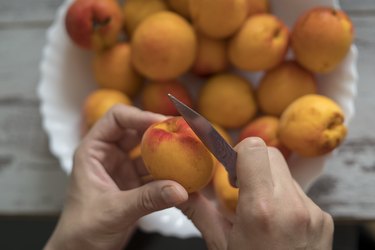
Several types of fruit trees are among the plants that grow well in South Dakota, including stone fruit, like cherries, plum and apricots, as well as apples, crabapples and pears. When choosing fruit trees for South Dakota, it is important to keep the state's climate zones in mind. Most of the state falls in U.S. Department of Agriculture plant hardiness zones 4a to 5b. Even if the trees meet the hardiness requirement, in Northern regions, fruit tree flowers remain vulnerable to late spring frosts.
Mesabi Cherry for South Dakota
Video of the Day
Cherry trees are divided into two groups: sweet and tart. Only the latter trees are hardy enough to survive winters in South Dakota. Unlike sweet cherry trees, which must be pollinated with the pollen of a different variety of tree to bear fruit, tart cherries are self-fruitful, which means they can set fruit with their own pollen. This is an advantage in small garden spaces.
Video of the Day
The Mesabi cherry tree (Prunus 'Mesabi,' zones 4-8), a cross between sweet and tart cherries that is sweeter than most tart cherries, is also an option in South Dakota. The dwarf cultivars North Star (Prunus 'North Star,' zones 4-8) and Meteor (Prunus 'Meteor,' zones 4-8) are also sour cherry trees recommended for South Dakota. Meteor is particularly hardy, capable of tolerating temperatures as low as -40 degrees Fahrenheit.
Apricot and Plum Trees
In addition to cherries, two other types of stone fruits – fruit that have an inedible, stonelike pit in the center – can be grown in South Dakota: apricots and plums. When it comes to apricots, two varieties, Moongold (Prunus armeniaca 'Moongold,' zones 4-8) and Sungold (Prunus armeniaca 'Sungold,' zones 4-8), are hardy enough to survive winters in South Dakota. These trees also require multiple varieties for pollination. The fruit of the Moongold apricot tree has a freestone, which means that the inedible pit in the center of the fruit is not attached to the flesh. Sungolds are small and have a mild flavor.
It is also possible to grow cultivars of the American plums (Prunus americana, zones 3-8) in South Dakota. In the warmer parts of the state, consider growing Superior (Prunus 'Superior,' zones 4-8), which can survive temperatures as low as -30 degrees. This species must be pollinated with the pollen of a different plum tree. The Toka plum tree (Prunus americana 'Toka,' zones 3-8), also known as the bubblegum tree, produces fruit that is slightly spicy and is a great cultivar tree to plant in order to pollinate other plum trees.
Apple and Pear Trees
A number of apple trees are recommended for South Dakota, including Sweet Sixteen (Malus 'Sweet Sixteen,' zones 4-7), the fruit of which is sweet and crisp and a good option for eating fresh, baking and making juice. Redfree (Malus 'Redfree,' zones 5-8) is also recommended for South Dakota and stands out because of its disease resistance. Two different apple varieties are required for pollination and fruit production. Crabapple trees can also pollinate apple trees.
Among the pear trees recommended for South Dakota is the Golden Spice pear (Pyrus 'Golden Spice,' zones 3-7), which is one of the hardiest varieties of pear. This cultivar produces fruit that is relatively small but good for canning and making jams and jellies. The Luscious (Pyrus ussuriensis 'Luscious,' zones 4-8) and Gourmet (Pyrus ussuriensis 'Gourmet,' zones 4-8) trees are also recommended for South Dakota. However, they are self-sterile and cannot pollinate other pear trees.
- South Dakota State University Extension: Fruit Variety - 2019 Recommendations for South Dakota
- Missouri Botanical Garden: Prunus 'North Star'
- Missouri Botanical Garden: Malus 'Sweet Sixteen'
- South Dakota State University Extension: Plant Hardiness Zones
- Missouri Botanical Garden: Malus 'Redfree'
- University of Minnesota Extension: 'Meteor Cherry' - Prunus Cerasus 'Meteor'
- University of Minnesota Extension: Superior Plum - Prunus 'Superior'
- University of Minnesota Extension: Growing Stone Fruits in the Home Garden
- Minneopa Orchards: Toka Plum: The Bubblegum Plum